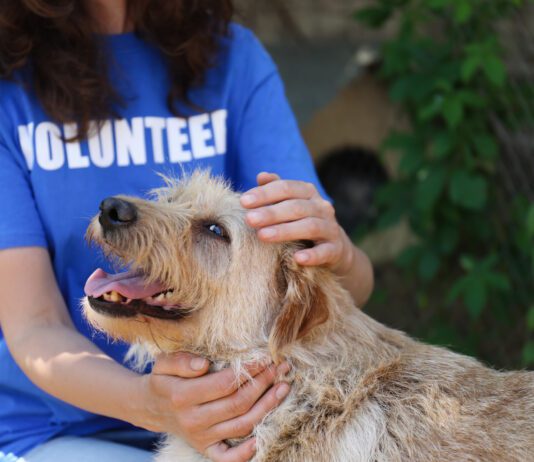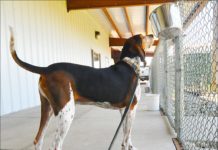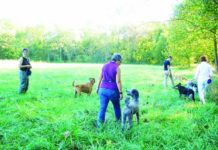When Service Dogs Misbehave
Responsible service-dog handlers aim to keep their dogs as inconspicuous as possible, and are quick to take corrective action if the dog's behavior becomes problematic. When they don't, businesses are legally allowed to ask the handler to remove the dog. While many business owners are afraid to exercise this right, not doing so has created significant problems for the disability community.
Lifting Your Dog
1.Place both hands briefly, gently, on either side of your dog's spine, and then feed him a treat.2.Gradually move your hand down and under your dog's ribcage on the far side, touching and feeding him a treat several times at each step.3.Gradually move your other hand around the front of your dog's chest to his opposite shoulder, touching and feeding him several times at each step.4.Put light pressure on your dog with both hands, gradually hugging him toward you, and then feed him a treat.5.Gradually increase pressure, feeding him treats several times at each step.6.Hug your dog against your chest, lifting upward slightly; release and treat.7.Gradually increase the amount of lift pressure until you are picking him up, giving him a treat several times at each step.
How to Create Just a Little More Physical Space Between You and Your Dog...
you can direct her out of your way by having her follow your hand with her nose.üStart teaching Off" with a tossed-treat lure; then
5 Things To Do If You Witness Animal Abuse
I assume that most Whole Dog Journal readers are as upset as I am when I see someone treating a dog badly. What should you do when you see someone being rough with their dog? Hard as it may be, I urge you to be calm and take several deep breaths before you act. Then . . .
The Healing Power of Dogs
prior to her diagnosis with end stage renal disease. Williams was an avid bodybuilder
Can Dogs Really Detect Cancer in Humans?
The dog's nose is an amazing organ, with abilities and features far superior to our own in many ways. First are the physical adaptations of the nose itself. The inside of the dog's nose is lined with many folds of tissue (called the olfactory epithelium), which in turn contain hundreds of millions of olfactory receptors, specialized cells responsible for detecting odors. Because of the increased surface area caused by these folds, the dog's nose contains a ridiculously high number of receptor cells when compared to the human nose; on average, the dog has about 220 million, while our noses harbor a paltry 5 million. This difference contributes to the dog's ability to detect almost impossibly minute concentrations of compounds, by some estimates in concentrations as low as parts per trillion.
Interview with Laurel Braitman – Author of “Animal Madness”
Dogs can change our lives. Little did Laurel Braitman know how much one Bernese Mountain Dog would change hers. Not long after Laurel had adopted Oliver, the 4-year-old dog began to exhibit anxious behaviors, soon culminating in his exodus from the window of her fourth-story apartment. A young neighbor boy witnessed Oliver's fifty-foot fall and screamed, Mom! A dog fell out of the sky!"
"
Productive Ways to Train Your Dog
Life with any dog has its moments of agony and ecstasy. The ecstasy happens when our dogs' behaviors are top notch, and all systems seem to run smoothly. The agony happens when our dogs have an oops" moment
Preparing Your Dog for Airplane Travel
The ability to carry a little dog onto an airplane with you is one of the greatest advantages of owning a small dog that can't be shared by owners of medium or large dogs. Most (though not all) of the risks of flying a dog on a commercial flight are posed by the dog's handling by airport employees behind the scenes and by the dog's unattended experience in the cargo hold of the plane; in contrast, the risks to a dog who is with you at every moment of your flight are very slight and under your control. That said, there are a lot of things you need to know and contingencies for which to prepare if you are going to subject your dog to air travel. Here's how to make the carried-on dog's flight as enjoyable and stress free (for both of you) as possible.
How to Catch a Dog on the Loose
but most will send an officer right away if the dog is contained."
Finding a Reliable Dog Walker
This past summer, my niece, who was home on college break, picked up a job walking her neighbor's dog. After a few outings, she contacted me because this fairly large dog she was walking had some behavioral issues and she wanted some suggestions on how to work with him. My advice to her was that this wasn't a job for a novice dog walker; after some discussion she agreed but wanted to pass along some recommendations for other walkers to the owner. Knowing this dog had special needs and not knowing anyone in the dog's area myself to recommend, I turned to my colleague Veronica Boutelle to get the inside scoop on finding a dog walker.
Professional Dog Training Titles
Not to be outdone by the veterinary profession (See Alphabet Soup














